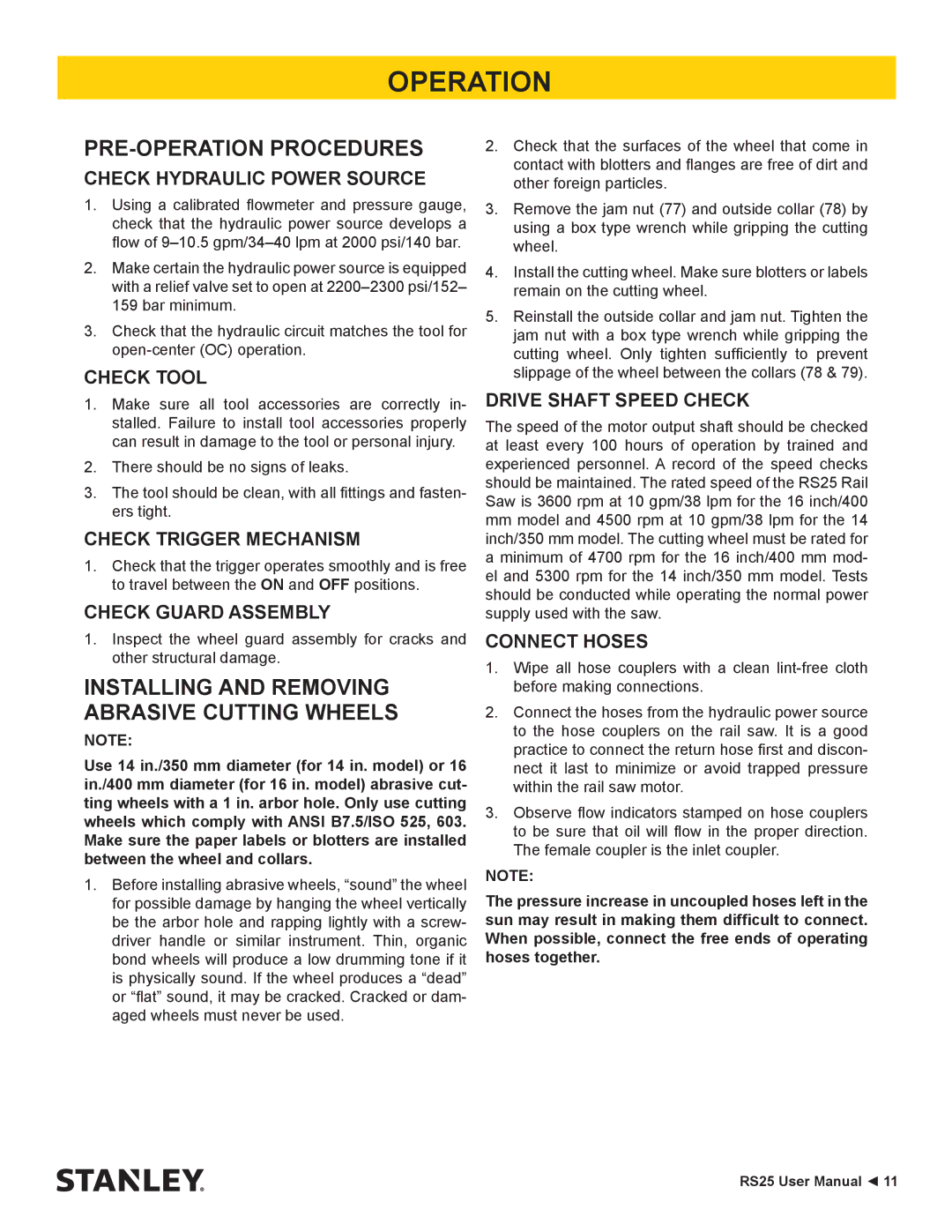
OPERATION
PRE-OPERATION PROCEDURES
CHECK HYDRAULIC POWER SOURCE
1.Using a calibrated flowmeter and pressure gauge, check that the hydraulic power source develops a flow of
2.Make certain the hydraulic power source is equipped with a relief valve set to open at
3.Check that the hydraulic circuit matches the tool for
CHECK TOOL
1.Make sure all tool accessories are correctly in- stalled. Failure to install tool accessories properly can result in damage to the tool or personal injury.
2.There should be no signs of leaks.
3.The tool should be clean, with all fittings and fasten- ers tight.
CHECK TRIGGER MECHANISM
1.Check that the trigger operates smoothly and is free to travel between the ON and OFF positions.
CHECK GUARD ASSEMBLY
1.Inspect the wheel guard assembly for cracks and other structural damage.
INSTALLING AND REMOVING ABRASIVE CUTTING WHEELS
NOTE:
Use 14 in./350 mm diameter (for 14 in. model) or 16 in./400 mm diameter (for 16 in. model) abrasive cut- ting wheels with a 1 in. arbor hole. Only use cutting wheels which comply with ANSI B7.5/ISO 525, 603. Make sure the paper labels or blotters are installed between the wheel and collars.
1.Before installing abrasive wheels, “sound” the wheel for possible damage by hanging the wheel vertically be the arbor hole and rapping lightly with a screw- driver handle or similar instrument. Thin, organic bond wheels will produce a low drumming tone if it is physically sound. If the wheel produces a “dead” or “flat” sound, it may be cracked. Cracked or dam- aged wheels must never be used.
2.Check that the surfaces of the wheel that come in contact with blotters and flanges are free of dirt and other foreign particles.
3.Remove the jam nut (77) and outside collar (78) by using a box type wrench while gripping the cutting wheel.
4.Install the cutting wheel. Make sure blotters or labels remain on the cutting wheel.
5.Reinstall the outside collar and jam nut. Tighten the jam nut with a box type wrench while gripping the cutting wheel. Only tighten sufficiently to prevent slippage of the wheel between the collars (78 & 79).
DRIVE SHAFT SPEED CHECK
The speed of the motor output shaft should be checked at least every 100 hours of operation by trained and experienced personnel. A record of the speed checks should be maintained. The rated speed of the RS25 Rail Saw is 3600 rpm at 10 gpm/38 lpm for the 16 inch/400
mmmodel and 4500 rpm at 10 gpm/38 lpm for the 14 inch/350 mm model. The cutting wheel must be rated for a minimum of 4700 rpm for the 16 inch/400 mm mod- el and 5300 rpm for the 14 inch/350 mm model. Tests should be conducted while operating the normal power supply used with the saw.
CONNECT HOSES
1.Wipe all hose couplers with a clean
2.Connect the hoses from the hydraulic power source to the hose couplers on the rail saw. It is a good practice to connect the return hose first and discon- nect it last to minimize or avoid trapped pressure within the rail saw motor.
3.Observe flow indicators stamped on hose couplers to be sure that oil will flow in the proper direction.
The female coupler is the inlet coupler.
NOTE:
The pressure increase in uncoupled hoses left in the sun may result in making them difficult to connect. When possible, connect the free ends of operating hoses together.
RS25 User Manual ◄ 11
